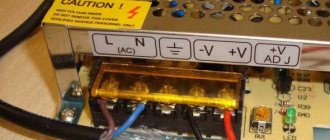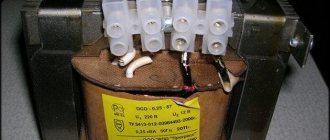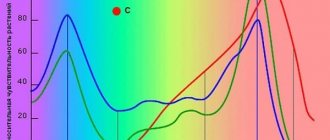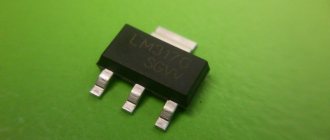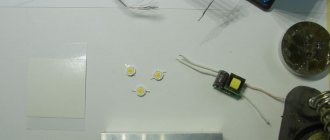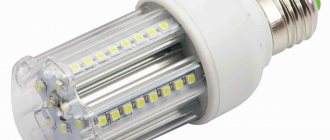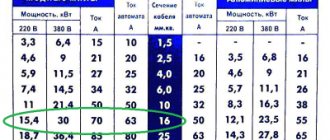The use of LED strips for lighting residential, office and commercial premises today will not surprise anyone, but the popularity of LED technologies is due not only to fashion. Semiconductor light sources have low power consumption and a long service life. Their only drawback is their higher cost compared to other types of lighting devices. At the same time, the price factor is significantly influenced by the price of the electronic ballast (transformer), the power supply necessary for the operation of the LED strip.
In this publication we will consider a number of issues related to power supplies for LED light sources. The collected information will help you select an adapter based on power and voltage, correctly connect the tape to it, and also make a simple power supply for lighting with your own hands.
What is electronic ballast and why is it needed?
The need for this device is due to the fact that the supply voltage of strip LEDs is 12 volts (or 24 volts). Accordingly, to connect to the home electrical network you will need a 12-volt step-down power supply, equipped with an AC-to-DC voltage converter.
Despite the fact that both switching and transformer power supplies can be used to operate devices, the latter are not widely used. This is due to both the large dimensions and weight, which pose the problem of where to hide such an adapter, and the low efficiency. In addition, the power transformer “buzzes,” which causes a fair amount of discomfort. But due to the ease of implementation, such schemes are popular among beginning radio amateurs.
Manufacturers of power supplies for diodes prefer to use pulsed circuits, which allows them to increase the power of the adapters and reduce their size and cost. Detailed information about switching power supplies can be found on our website.
Sometimes such power supplies are called “transformers” for LED strips, which is not entirely correct, because we are talking specifically about pulse voltage converters, but since this term is firmly established, we will also use it.
A step-down transformer
Step-down transformer for LED lamps
The standard service life of LED lamps, in accordance with the characteristics declared by the manufacturers, is 4000 operating hours. If you do not use specialized step-down transformers in the operation of such devices, leaving the diode as the basis of operation, the operating period is reduced to 1200 hours of uninterrupted operation.
If lamps are installed in rooms with high moisture concentrations or constant temperature changes (saunas, swimming pools), you need to use a special step-down transformer equipped with protection from water. It is also important to ensure that the total load of LED lamps is within 60%.
How to choose
There is nothing difficult in choosing a step-down transformer for LED lamps. If any difficulties arise, you can always consult with managers of companies that sell such equipment. The most important thing is to correctly calculate the power.
The sum of all LED lamps installed in the room is calculated, 20% is added to the result obtained, since in the vast majority of cases only one transformer is used.
For example, there will be six 12V lamps in the room, their total is 72V. Devices rated at 60V can no longer be used. You need to purchase 100V equipment or reduce the number of light sources. If you install a powerful transformer, you can add another lamp.
Savings do not depend on the power of the light sources used, but on the voltage. This is achieved through the use of a transformer, which significantly increases the service life of LED lamps.
Power supply options for LED strips
Depending on the functional purpose, electronic ballast is available in the following versions:
- In the form of a compact network power supply. Such devices look like regular chargers for mobile devices.
Compact network power supplies for LED strips
This solution can be called an economical option, since of all types of execution it is the lowest in cost. The downside is low power, as a rule, it does not exceed 30-36 W (there are Chinese products with 60 W, but in them this parameter is greatly overestimated). The main area of application is connecting simple lighting. The main advantage is that no installation is required; the driver just needs to be plugged into a socket, having previously connected a tape to the output.
- Compact unit housed in a sealed plastic case. The maximum power of such devices is 75 W. The 100 W figure found on Chinese products is not true.
Sealed compact electronic ballast, sealed from external influences
Distinctive features: light weight, compact size, protection from moisture and dust. This is an almost ideal option for organizing lighting in ceiling niches, if you do not take into account the high cost of the adapter (almost twice as expensive as analogues with a non-sealed housing).
- Electronic ballast in a sealed aluminum housing. This version is designed for harsh operating conditions. The scope of application of such power supplies is lighting of outdoor advertising, lighting of buildings and other objects where high-power LEDs are installed. Installing household light sources as an adapter is not economically justified.
Arlight power supplies in a sealed aluminum case
Distinctive features: resistance to mechanical stress and destructive natural factors (rain, snow, UV radiation). As for power, taking into account the frequent production of such adapters on special orders, it can be in a fairly wide range. For standard products, this parameter is usually from 80 to 200 W. The price is significantly higher than other options.
- Leaky ballast. The most popular power supply unit is widely used to power lighting in apartments, offices and retail spaces. It costs a little more than a compact network unit, but can be much more powerful with the same dimensions.
PSU in non-hermetic version
Powerful devices of this type can be equipped with forced ventilation, which ensures cooling of electronic components, which extends the life of the adapters. They are manufactured for 12 or 24 V voltage. The low price and wide range, allowing you to choose the most optimal option, have made such power supplies the most popular. https://www.youtube.com/watch?v=xsyVQBIUFR0
Product characteristics
LED strips are long elastic boards on which contacts and diodes are located. There is a certain distance between them. To limit the current flowing through the system, special resistors are soldered into the structure.
Designers often use LEDs for interior decoration, visually expanding the space of a room, and hiding light sources when arranging various ceiling structures.
There are several types of LED designs. Some of them :
- Adhesive. To fix the product, it is necessary to remove the protective film from the adhesive layer and, bending the tape at the desired angle, apply it to a flat surface.
- Glueless. Special plastic brackets are used for fastening.
- Moisture-proof ones are in demand when installing lighting in rooms where there are high humidity levels.
- Sealed ones are needed for lighting systems in places of high humidity, as well as in swimming pools.
- Open. Used for mounting lighting under ceiling structures or on walls.
- Multicolor systems change color characteristics under the influence of a special element - a controller.
- Single color (white). Their brightness level can be adjusted with a special dimmer.
Ice systems can have a varied number of lighting elements of various types. The most popular devices are marked 3528 or 5050. Digital values indicate the size of the diodes: 3.5 by 2.8 mm or 5 by 5 mm. The first ones are equipped with a special plastic case with one crystal. The latter also feature a plastic design that houses three crystals, so they illuminate much brighter.
In addition, today double-row systems with many diodes are produced. In stores you can purchase new products that are equipped with SMD 2850 chips. With their help, the light characteristics are significantly improved.
Due to their low cost and high light output, the products are becoming popular every day. Such tapes operate in a safe mode with reduced current levels. This factor helps to increase the service life without loss of brightness. They can work 50 thousand hours. These are the figures stated by the manufacturer.
You may be interested in Features of illumination measurement
Advantages of designs
LED systems are characterized by minimal electricity consumption. Now there are many types with different power ratings from 4.8 to 14.4 W/min and higher. Diodes produce fairly bright light, so they can be used not only for auxiliary lighting, but also as the main light source. Often, the brightest LED-TED strips are used for this.
LED lighting has a number of undeniable advantages compared to other lighting systems. Some of them :
- Long service life of at least 10 years.
- Lighting is distributed evenly over the entire room.
- High fire safety indicators.
- The light remains bright throughout the entire operational period.
- Environmentally friendly materials in the composition.
- Minimum electricity consumption.
- Possibility of fixing the tape at different angles.
- Varied color palette.
- LEDs do not contain mercury.
- Resistance to radio interference.
- A minimum of thermal energy is released into the room.
Briefly about management
Speaking about drivers for LED strips, one cannot fail to mention the devices that control their lighting, in particular, dimmers and RGB controllers.
Since switching power supplies are used for power supply, it is not possible to regulate the intensity of the strip LEDs by changing the voltage, as for incandescent lamps. For this purpose, you will need to purchase a special device - a dimmer, for example the one shown in the figure below.
Dimmable module for monochrome LED strip
Such a device is connected to the gap between the power supply and the tape.
To control RGB strips, a special device is used, as a rule, it is based on a microcontroller. As a rule, it is “protected” by several programs that allow you to both control the intensity of the glow with a predominance of one color or another, and use other lighting effects (videos demonstrating them are easy to find on the Internet).
RGB controller with remote control
The controller is turned on in the same way as the dimmer (between the power supply and the tape).
How to choose a transformer for LED strip?
First of all, it is necessary to determine the main characteristics of the power supply. For us the following are significant:
- input voltage.
- output voltage.
- rated load current.
There will be no difficulties with the first parameter; it must meet the standards of the home electrical network. The output voltage must be selected according to the power supply of the tape; it should be 12 or 24 volts. As for the power of the adapter, it is calculated based on the rated load current, taking into account the characteristics of the tape and its expected length. We'll tell you in detail how it's done.
Calculation of power supply power for LEDs
To calculate how much power a power supply needs, first let’s remember the derivative of Ohm’s law: in our case, P is the calculated power, I is the rated load current, U is the supply voltage.
The question is what does the length of the tape have to do with it? It’s easier to explain with an example. Let's say that to implement the project we need three meters of monochrome SMD 3528 12 volt tape. The table of its characteristics indicates a power of 4.8 W/m. Based on this, the calculated power for 3 meters will be 14.4 W. Taking into account the optimism of manufacturers, we add a margin of 30%, and we get 18.42 W. Therefore, we will need a power supply with a load current of at least 1.5 A (18.42/12).
As you can see, there is nothing complicated in the calculations; the main thing is to take into account the load characteristics. As an example, below is a table showing what types of 12 volt LEDs there are.
Table: example of characteristics of 12 volt LED strips
Please note that the standard length of the tape is 5 meters, but it is allowed to use smaller pieces (how the cut is made is indicated on our website) or connect two full-size pieces or more at once. How to do this will be discussed below.
Classification and principle of operation
The power supply comes in two versions:
- transformer based;
- pulse device.
Both options supply 12 volts to the input of the lighting fixture. The transformer power supply is characterized by rather large dimensions, which sometimes complicates the installation task. There are other disadvantages to such models: susceptibility to network overloads, as well as low efficiency. The pulse analogue, on the contrary, is compact, making it easy to hide anywhere.
The operating principle of such devices is to reduce the mains voltage to the required level (12V, 24V). Moreover, unlike drivers (providing stable current) used to power LEDs in LED lamps, the power supply is a voltage source.
Accordingly, the lighting device is not limited in current by this device. For this purpose, the design of the diode strip provides current-limiting resistors.
Different types of transformers
There are different types of transformers, different in design:
- compact plastic case;
- aluminum sealed housing;
- perforated body.
Each option is designed for use in different conditions. For example, the second option can come into contact with water without changing the characteristics, and a power supply with a perforated case, on the contrary, is used only in dry rooms and must be well protected from dust.
Connecting a transformer to an LED strip
As a rule, this stage does not cause difficulties, since most manufacturers, such as Feron or Arlight, include detailed instructions with their products. For those who have chosen a nonname, we will tell you how to connect an LED to 24 or 12 volts.
Two connection schemes are practiced: direct and parallel, they are presented below in the picture.
Connection diagrams A) straight; B) parallel
As a rule, a sequential connection scheme for several tapes is not practiced, except in cases where the total length of the tape does not exceed 5 meters.
The wires are attached to the DIN rail on the power supply unit, where the purpose of each contact is indicated (an example is shown in the photo below).
An example of connecting a tape to a power supply
The wires are soldered to the tape or special adapters are used for connection. As for the distance from the power supply to the tape, the smaller it is, the better. In practice, adapters are rarely installed far from light sources, so the cable length is not taken into account.
Choice
We have already discussed how to choose the power of a transformer. However, in some cases it is more advisable to use several low-power transformers instead of one powerful device. This can be done, for example, based on considerations of the location of individual sections of the LED strip. Or, based on the dimensions, when the question arises of where to hide a high-power transformer.
We have already dwelled on the advantages of “electronic” transformers. However, the electronic components used in them are more demanding for effective cooling. Often, to cool the electronics of such power supplies, fans are installed inside the case.
The choice of power supplies should be approached with some caution, since over time the fans sometimes begin to make quite loud noise and measures have to be taken to eliminate the noise. It is better to opt for converters in which the housing serves as a radiator for heat removal. Such cases have a developed ribbed surface.
When choosing a transformer, you need to consider the location of its installation. If the lighting is intended to be installed outdoors or in damp rooms, it is necessary to select a device with the appropriate protection class.
Additionally, you can watch an interesting video about choosing a transformer. The author gives useful comments that will definitely come in handy when choosing a transformer.
Homemade 12 volt transformer power supply
In conclusion, we present a simple power supply circuit for powering an LED light source with a power of up to 120 W based on the KR142EN8B integrated stabilizer.
Power supply circuit for 12 volt LED strip
Designations:
- Resistors: not used in the circuit.
- Capacitors: C1 and C2 – 100 nF; C3 – 1000 µF x 25 V; C4 and C5 -2200 uF x 25 V.
- Rectifier: VD1 – diode bridge KVRS 15005 or any other, designed for a current of at least 10 amperes;
- Diode VD2 – 1N4005 (any silicon diode will do as an alternative).
- Transistor VT1 is TIP 3005; in fact, any bipolar circuit with a collector current of 10.0 A or more is suitable.
- The DA1 chip is an integrated stabilizer KR142EN8B; as an alternative, you can use MC7812VT or similar analogues.
- TP1 – it is allowed to use any step-down transformer with a secondary winding designed for a voltage of 12-18 V and a load current of 10.0 A.
The assembled circuit does not require adjustment if the assembly was done correctly. This power supply can power both a regular 12 volt 60 watt strip and more powerful light sources.
Assembling a switching inverter power supply from scratch is futile. It is easier to adapt a ready-made device for this purpose, for example, take an electronic balance from energy-saving lamps that burned out in a chandelier and repair it by making small changes (increase the voltage and current consumption). In essence, these are ready-made switching power supplies.
Related questions
Quite often you can hear the question of where 24 volt strips are used; as a rule, they are used for lighting. They can be attached with adhesive tape to a special substrate that dissipates heat or placed in a profile for an LED strip mounted on the ceiling or walls. The selection of a power supply, power calculation and connection diagram for LEDs to 24 volts is carried out according to the same principle as described above.
What to do if one or more diodes burn out? Repair in this case does not require much effort. It is necessary to visually find the burnt segment; it is quite easy to identify it by its appearance; then it is cut out according to the marks on the tape. The remaining pieces should be connected with a wire of the appropriate cross-section, observing polarity. SMD elements are quite small, there is no point in re-soldering them; it is better to remove the burnt-out segment. The loss of one of them will not globally affect the total power of the light source.
How many tapes can you connect to the power supply? It all depends on the power of the adapter and the characteristics of the light source that is powered by it.
What should I do if I hear crackling or other unusual sounds from the electronic ballast? You should immediately turn off the power and perform a technical inspection of the device.
Types of drivers
There are several types of power supplies for LED lamps on sale. The main ones are the following:
- capacitor circuit;
- resistor;
- driver with low-voltage input;
- chip HV9910;
- network driver;
- LM317 chip.
The choice depends on the characteristics of the device and its operating parameters.
